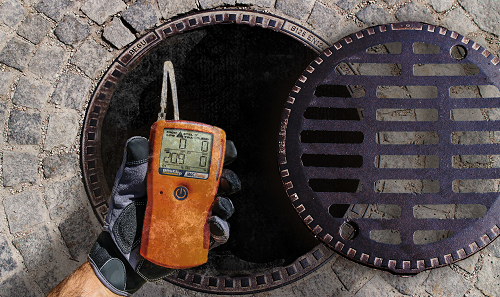
Everyone has heard the line, “What they don’t know won’t hurt them.” It is a lie that people frequently use as an excuse to keep something secret. However, the truth of the matter is that what a person does not know is usually what hurts them in the end, particularly in confined spaces. The atmosphere in those areas can make breathing dangerous if not fatal due to the types of gases that can potentially fill the air, such as hydrogen sulfide (H2S).
Hydrogen Sulfide (H2S)
This highly toxic gas is commonly produced by different industrial processes, such as petroleum extraction, agricultural silos, and even food processing. However, it is also frequently found in nature, particularly wherever decomposition is prevalent—such as in marshy landscapes, hot springs and manure pits.
Should a worker be exposed to hydrogen sulfide (H2S), the side-effects depend on the duration of exposure and the amount of gas present. For example, at 0.01 – 1.5 ppm, the gas smells like rotten eggs; and as long as everyone leaves the area as soon as it is detected, no permanent harm is done. If the amount of gas is higher or the exposure longer, then over time the employees could experience eye irritation, headache, stomach upset, loss of smell and other symptoms of varying degrees. Unfortunately, if the amount of hydrogen sulfide (H2S) hovers around 1000-2000 ppm, death is almost instantaneous.
Carbon Monoxide (CO)
Another common and equally dangerous gas is carbon monoxide (CO). It is odorless, tasteless, colorless, and can be found wherever fossil fuels are burned—such as in vehicles and certain power tools. Workers die every year because they use that type of equipment without proper ventilation—a circumstance that greatly increases during the winter months. Employees inevitably create a confined space by closing all the doors and windows to keep the area warm; and without a reliable gas detector, they cannot properly monitor the fumes created by their equipment.
Like hydrogen sulfide (H2S), the side effects of exposure to carbon monoxide (CO) vary based on duration and the amount of gas present. For example, 0.5 – 5 ppm is the typical amount that one would find outdoors in a major metropolitan area and carries little to no risk of side effects. However, if an individual spent 8 hours in a confined space where the gas level sat at 50 ppm, they could expect to have a headache and dizziness. Once the carbon monoxide (CO) level reaches 6,400 ppm, a person would be unconscious after two or three breaths and dead within 15 minutes.
Oxygen (O2)
As awful as the side effects are for both carbon monoxide (O2) and hydrogen sulfide (H2S), the real root of the problem is that they both displace the oxygen (O2) in the air and thereby poison the exposed individual’s blood. On the other hand, having too much oxygen (O2) in an area’s atmosphere can be equally as dangerous. Breathable air is generally 20.8% - 21% oxygen (O2). However, if that gas rises above 22%, the atmosphere becomes explosive. This situation can be created by various chemical reactions, a leaking oxygen (O2) hose or even a liquid oxygen (O2) spill.
Fortunately, breathing oxygen-enriched air does not cause any adverse effects in the short term. However, if one does it for an extended period, the alveoli in their lungs can collapse. The patient can also experience retinal detachment and even seizures. Recovery is possible once the individual’s oxygen (O2) levels return to normal.
Safe Practices
All-in-all, the best way to keep oneself safe when entering a confined space is to follow the motto of scouts worldwide—be prepared. Have a plan that addresses what to do if the atmosphere is already dangerous before entering the area as well as one for if workers are already in a space when the atmosphere becomes precarious. Both cases require testing and continually monitoring the air using a certified gas detector or pump, such as the MGC Pump from Gas Clip Technologies. Lastly, never enter a confined space without someone on site who knows the emergency plan and can execute it should the situation turn dangerous. Life is too precious for reckless decisions, so treat it with care. Take precautions and remain aware.




